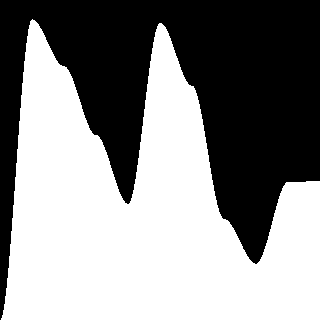Workshop GLSL - Noise - Chapter 6.2 - Noise 1D

Explanations
Now let interpolate some noise values
#define PROCESSING_COLOR_SHADER
uniform float time;
uniform vec2 resolution;
float hermite(float t)
{
return t * t * (3.0 - 2.0 * t);
}
this is our 1D random function
float rand(float x){
return fract(sin(x * 12.9898) * 43758.5453);
}
And this is our 1D noise version.
float noise(float x, float frequency)
{
float v = x * frequency;
float ix1 = floor(v);
float ix2 = floor(v + 1.0);
float fx = hermite(fract(v));
return mix(rand(ix1), rand(ix2), fx);
}
void main( void ) {
vec2 position = gl_FragCoord.xy / resolution.xy;
let’s try with a noise at frequency 10
float y = noise(position.x + time * 0.1, 10.0);
float v = step(position.y, y);
gl_FragColor = vec4(v,v,v,1.0);
}
Full Code Source
#define PROCESSING_COLOR_SHADER
uniform float time;
uniform vec2 resolution;
float hermite(float t)
{
return t * t * (3.0 - 2.0 * t);
}
float rand(float x){
return fract(sin(x * 12.9898) * 43758.5453);
}
float noise(float x, float frequency)
{
float v = x * frequency;
float ix1 = floor(v);
float ix2 = floor(v + 1.0);
float fx = hermite(fract(v));
return mix(rand(ix1), rand(ix2), fx);
}
void main( void ) {
vec2 position = gl_FragCoord.xy / resolution.xy;
float y = noise(position.x + time * 0.1, 10.0);
float v = step(position.y, y);
gl_FragColor = vec4(v,v,v,1.0);
}



